Articles, letters, and poems regarding Wattle Day, the Wattle Day League, and wattle trees.
(Arranged in chronological order.)
The Wattle Tree [poem, 1 January 1876]
Wattle bloom [by F.M., 31 August 1889]
A lengthy article regarding wattle trees, and more. The last paragraph foreshadows a Wattle Day: “Shall we ever see a Wattle Bloom day in Australia? Who knows? We have yet to establish all our national festivals.”
Ode to the Wattle Blossom [poem, 27 September 1889]
To the Wattle Blossom [poem, 19 July 1894]
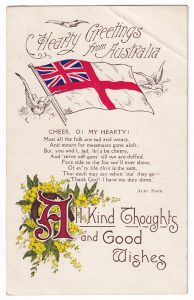
A postcard (unused), which incorporates a poem, as well as an illustration of a British naval flag (the white ensign), and a wattle design. It is estimated to have been published in the early 20th Century.
Best Wishes [postcard, early 20th Century]
A postcard, which incorporates a poem, as well as an illustration of some kookaburras, along with some embedded wattle blossoms in an outline of a heart. It is estimated to have been published in the early 20th Century.
[After the rescue of the guns at Lindley] [22 November 1900]
A brief item (an extract from the “Personal” section) which says that Ellie Wemyss, a young girl from South Australia, sent sprigs of wattle to Australians involved in a military action in the Boer War (1899-1902), as a patriotic keepsake and in recognition of their bravery. See also the poem (in this list) dated 1 September 1910.
To a Sprig of Wattle! [poem, 3 July 1906]
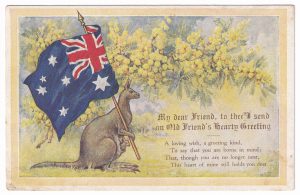
An patriotic postcard (unused), which incorporates a poem, as well as an illustration of a kangaroo, carrying an Australian flag, with golden wattle in the background. It is estimated to have been published about 1901-1908.
The Grove of Wattles [poem by Agnes L. Storrie, 1909]
This poem by Agnes L. Storrie (Agnes L. Kettlewell) was published in Poems (1909).
Proposed “Wattle Day” [26 August 1909]
A brief article about the intended inaugural meeting of the Wattle Day League, to be held on Monday 30 August 1909.
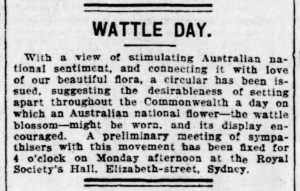
A notice of a meeting, to discuss the creation of a Wattle Day, to be held on Monday 30 August 1909.
Wattle Day: A good movement [31 August 1909]
An article about the notice of a meeting (held on Monday 30 August 1909) to create a Wattle Day (the article included the names of the meeting’s conveners).
[At the Royal Society’s House] [creation of the Wattle Day League, 1 September 1909]
An untitled article (an extract from the “Social Gossip” section) about the inaugural meeting of the Wattle Day League.
[Wattle Day is our new national institution] [by “Nimitybelle”, 8 September 1909]
An untitled item (an extract from the “Lady’s letter” section) about the newly-formed Wattle Day League.
[A meeting, largely attended] [re Wattle Day, 2 October 1909]
An untitled item (an extract from the “Orchard, Vineyard & Garden” section) about the inaugural meeting of the Wattle Day League.
Wattle Day [letter from J. H. Maiden, 30 August 1910]
A letter from J. H. Maiden, President of the Wattle Day League (NSW), promoting the concept of Wattle Day.
Wattle Day League [letter from Ellenor Symon and Muriel E. Farr, 30 August 1910]
A letter from Ellenor Symon and Muriel E. Farr (President and Secretary of the Wattle Day League in South Australia), promoting the concept of Wattle Day.
Wattle Day [letter from Agnes L. Kettlewell, 31 August 1910]
A letter from Agnes L. Kettlewell, Secretary of the Wattle Day League (NSW), promoting the concept of Wattle Day.
Golden Wattle [poem by S. T., 1 September 1910]
Golden Wattle, Australia’s Emblem [poem by Ellie Wemyss, 1 September 1910]
A poem by Ellie Wemyss. See also the article (in this list) dated 22 November 1900.
Wattle Day [8 September 1910]
A brief article about the first Wattle Day, and the activities of the Wattle Day League.
Wattle Day [9 September 1910]
A brief article about the first Wattle Day, and about the origin of the term “wattle” (regarding the tree).
A Wattle Badge [letter from Agnes L. Kettlewell, 15 August 1914]
Letter from Agnes L. Kettlewell, Secretary of the Wattle Day League (NSW), promoting the idea of Australian soldiers wearing Wattle Day badges, with the cost to be raised by public donations.
A Wattle Day Contrast [poem by Silas Lister, 7 September 1915]
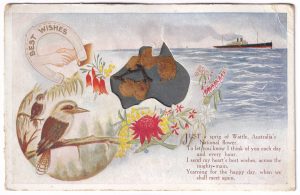
A postcard, which incorporates a poem, as well as an illustration of some kookaburras, along with some embedded wattle blossoms in an outline of Australia. It is dated 10 December 1917, during the First World War (1914-1918); it was sent to a sailor serving on HMAS Melbourne, from his mother.
A Whiff of Wattle [poem, 16 February 1918]
Wattle Day: Observance in State schools [5 July 1920]
A brief notice regarding the celebrating of Wattle Day by state schools on the 16th July 1920.
Wild flowers of Australia [poem by Caroline Carleton, 9 September 1922]
A Plea for Wattle Day [poem by Marion Miller Knowles, 19 August 1926]
A poem, by Marion Miller Knowles, written in support of raising funds for orphanages on Wattle Day.
Wattle Day [19 August 1926]
An article about fundraising activities on Friday 27 August 1926, to raise money for Catholic charities (published in The Advocate, a Catholic newspaper)
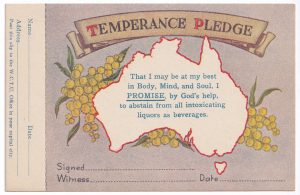 Temperance Pledge [postcard, early 20th Century]
Temperance Pledge [postcard, early 20th Century]
A postcard (unused), published by the Woman’s Christian Temperance Union, which incorporates a map of Australia (with the Temperance Pledge inside the map), with wattle blossoms in the background. The postcard is from the early 20th Century (possibly 1901-1930s).]
Wattle Day: An emblem and its meaning [by K. R. Cramp, 1 August 1936]
An article by Karl Reginald Cramp (Vice-President of the Wattle League) about Wattle Day.
[Why is … the Acacia … known as wattle?] [2 January 1953]
A brief article about the origin of the term “wattle” (regarding the tree).
Editor’s notes:
Agnes Kettlewell = Agnes Louisa Kettlewell (née Storrie) (1864-1936), poet, author, journalist, and Wattle Day campaigner; she was born in Glenelg (South Australia) in 1864, and died in Woolwich (Sydney, NSW) in 1936
See: “Agnes Louisa Storrie (Kettlewell)”, The Institute of Australian Culture
Hannah Clunies Ross = Hannah Elizabeth Clunies Ross (née Tilley) (1862-1947), Wattle Day campaigner; daughter of Charles Tilley (1824-1891), wife of William John Clunies Ross (1850-1914)
See: 1) “Hannah Elizabeth Tilley”, Geni
2) “Charles Tilley”, Geni
3) David Mason, “Hannah Elizabeth Tilley”, Geneanet [“Born 18 November 1862”]
4) David Mason, “Clunies-Ross”, Geneanet [family tree]
5) “Family history research guide”, NSW Registry of Births Deaths & Marriages
a) birth record: name: TILLEY, HANAH E; registration no. 3914/1863; father’s given name/s: CHARLES; mother’s given name/s: ELIZABETH; district: ST GEORGE [Note: the BDM record spells her name as “Hanah”, not “Hannah”]
b) death record (of father): name: TILLEY, CHARLES; registration no. 12562/1891; father’s given name/s: THOMAS; mother’s given name/s: PATIENCE; district: PETERSHAM)
6) “Marriages”, The Sydney Morning Herald (Sydney, NSW), 7 January 1888, p. 1 [marriage of Hannah Tilley to William J. Clunies Ross]
7) Bruce Mitchell “Clunies Ross, William John (1850–1914)”, Australian Dictionary of Biography
8) “William Clunies-Ross”, My Heritage
9) “Deaths”, The Sydney Morning Herald (Sydney, NSW), 23 December 1947, p. 18 [“CLUNIES ROSS, Hannah Elizabeth. — December 21, at Walsh Street, Deepdene”]
10) “Deaths”, The Argus (Melbourne, Vic.), 23 December 1947, p. 11 [“CLUNIES ROSS.—On December 21, at Walsh street, Deepdene, Hannah Elizabeth, widow of William John, of Sydney (NSW), and mother of Ian”]
11) “Search your family history”, Registry of Births, Deaths and Marriages, Victoria (death record: name: Hannah Elizabeth CLUNIES ROSS; mother’s name at birth: Elizabeth EGERTON; father’s name: William TILLY; place of birth: Petersham, New South Wales; place of death: Deepdene; Age at death: 85; reg. year: 1948, reg. no.: 160/1948) [although her death occurred in late 1947, it was not registered until early 1948]
[Note: Hannah Elizabeth Tilley’s father’s name is given variously as Charles and as William; it may be that his name was William Charles Tilley, or Charles William Tilley, although he was known by his middle name (which was a relatively common practice among those of British descent)]
J. D. Fitzgerald = John Daniel (Jack) Fitzgerald (1862-1922), compositor, trade unionist, journalist, barrister, and politician; he was born in Shellharbour (NSW) in 1862, and died in Darling Point (Sydney, NSW) in 1922
See: Bede Nairn, “Fitzgerald, John Daniel (Jack) (1862–1922)”, Australian Dictionary of Biography
J. H. Maiden = Joseph Henry Maiden (1859-1925), botanist, public servant, and Wattle Day campaigner; he was born in St John’s Wood (London, UK) in 1859, came to Australia in 1880, and died in Turramurra (Sydney, NSW) in 1925
See: 1) Mark Lyons and C. J. Pettigrew, “Maiden, Joseph Henry (1859–1925)”, Australian Dictionary of Biography
2) “Joseph Maiden”, Wikipedia
Rose Scott = Rose Scott (1847-1925), women’s rights activist and trade unionist; she was born in Glendon (near Singleton, NSW) in 1847, and died in Woollahra (Sydney, NSW) in 1925
See: 1) Judith Allen, “Scott, Rose (1847–1925)”, Australian Dictionary of Biography
2) “Rose Scott”, Wikipedia
Leave a Reply